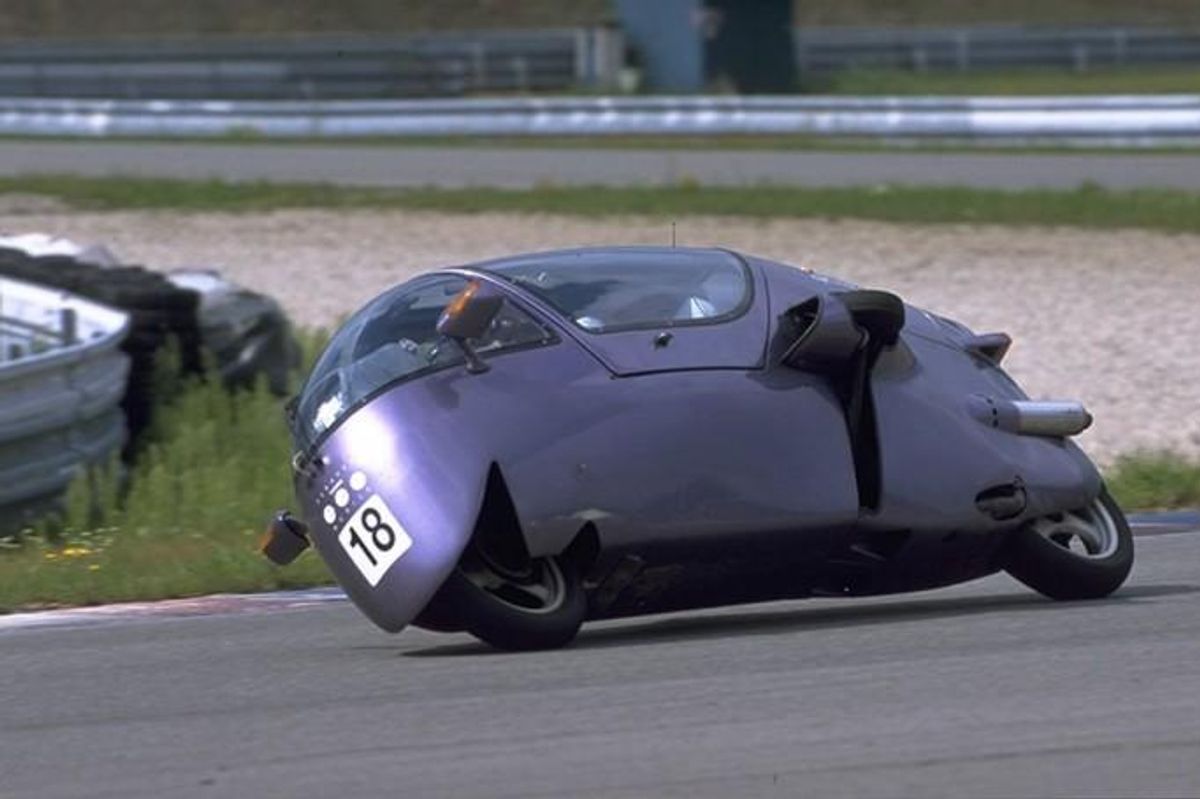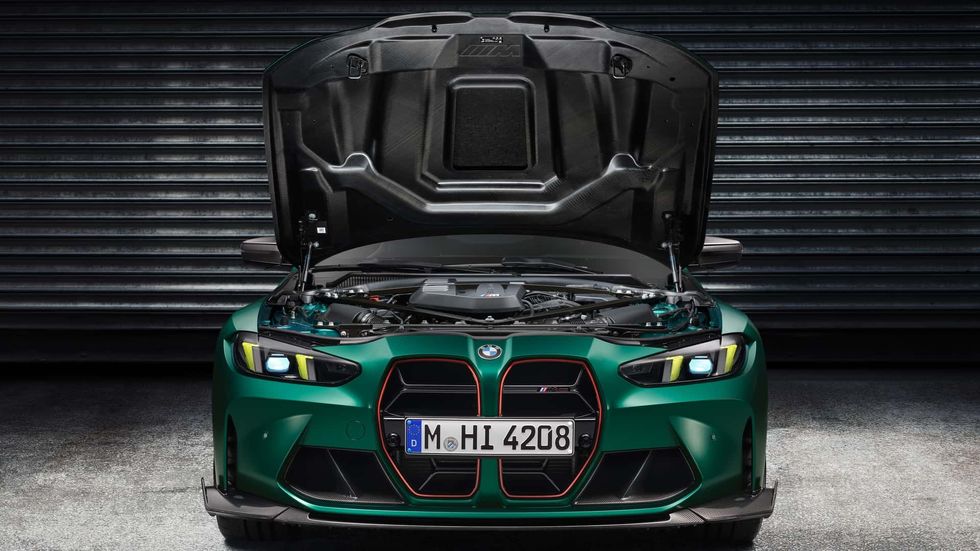
Buy
Resources
Entertainment
Magazine
Community
In This Article
Category:
Motorcycles
A Peraves EcoMobile at a track day in Europe. Photos courtesy Peraves AG.
Those with a background riding motorcycles understand one simple truth: Compared to cars, motorcycles simply deliver more entertainment value. They generally accelerate more quickly than automobiles, stop in shorter distances, involve the rider in the environment instead of isolating him from it and even deliver better fuel economy. In inclement weather, however, the enjoyment of riding a motorcycle is offset by the inconvenience of perpetually impaired vision, potentially frozen extremities, and the misery of wet clothing, even under the best of rain gear. The ideal commuter vehicle, then, would be one that exhibited the positive aspects of a motorcycle, while negating its drawbacks. By that definition, the forward-thinking Peraves EcoMobile and its modern equivalent, the Peraves MonoTracer, may qualify as the optimal daily driver.
The brainchild of Swiss airline pilot Arnold Wagner, the EcoMobile, designed in 1974, is best described as an enclosed-cabin motorcycle that comes as close as possible to recreating the experience of flying at ground level. Like its open-air, two-wheeled counterpart, the EcoMobile relies on two wheels instead of four, except at low speeds when operator-deployed outriggers give the EcoMobile stability when slowed or parked. Like a motorcycle, the EcoMobile is steered with handlebars instead of a steering wheel and is capable of impressive lean angles (again, like a sporting motorcycle) in corners. Thanks to low coefficient of drag, the vehicle delivers bike-like fuel economy of 50 MPG highway, yet can reach a sports car-like top speed in excess of 150 MPH. It even relies on a motorcycle engine for propulsion, specifically the "laydown" water-cooled four-cylinder borrowed from BMW's K series. Even in 100 horsepower form, it is strong enough to produce a 0-60 MPH time below six seconds.
An EcoMobile with its outriggers deployed.
Like an automobile, however, the EcoMobile features upright seating with back support and a headrest, utilizes three-point seatbelts, keeps rider and (in-line) passenger out of the elements and even boasts such available amenities as an audio system and air conditioning. Its design incorporates a long wheelbase and a low center of gravity for improved stability and handling, and the EcoMobile's Kevlar monocoque construction ensures the vehicle's safety. Wagner calls the EcoMobile the "safest two-wheeler ever built" and speaks of an (undeniably lucky) owner who crashed his EcoMobile at a speed of 250 KPH (155 MPH) and lived to tell the tale.
To be clear, the EcoMobile was not the first enclosed motorcycle, and the idea behind such a vehicle dates back nearly 100 years. The French-built Monotrace (which translates to "Single Track") was popular in the 1920s, and it's heritage traces back to the original German manufacturer, Einspur Auto (with "einspur" again translating to "single track"). The original Monotrace may have had a cabin and upright seating, but it used a retractable canvas roof, which proved suboptimal for both weather protection and high-speed operation. As affordable transportation, however, it offered those who couldn't afford four wheels a motorized alternative to the bicycle, while delivering (a bit) more practicality than the motorcycle.
A pair of EcoMobiles on tour.
The next logical evolution of the idea came in the 1930s, with an enclosed motorcycle called the Dalnik, built in Czechoslovakia. Featuring improved aerodynamics and side-by-side seating, Dalniks were constructed into the 1960s and came in a dizzying array of models, including open-air and fully enclosed variants. Some offered outriggers for stability, while others used floor hatches that allowed the operator to get his feet down at a stop. Given their diminutive size, Dalniks were both fuel-efficient and space-efficient, taking up far less garage or storage shed space than a conventional automobile. They were less expensive, too, adding to their popularity in both prewar and postwar Europe.
Of all the EcoMobile's strengths, however, a low selling price is not one of them. Essentially hand built in low volumes with premium components, manufacturer Peraves lacks the buying power associated with larger economies of scale, and the complex construction of the vehicle's Kevlar monocoque requires many hours of skilled labor. Even in the EcoMobile's early days, pricing was in the neighborhood of 88,000 Swiss francs, roughly the equivalent of $60,000. Despite this obstacle, Peraves constructed nearly 100 EcoMobiles between 1984 and 2005, before switching to the latest version, the Peraves MonoTracer, in 2007.
The electric-powered MonoTracer MTE-150.
The MonoTracer boasts the same advantages as the EcoMobile, but uses an updated Kevlar monocoque and features improved aerodynamics. The gasoline-powered MonoTracer MTI 1200 gets a 1.2-liter BMW four-cylinder engine, derived from BMW's K-LT series of luxury touring motorcycles, and can be ordered with such options as climate control, premium audio and electronic stability control. A 200hp electric-powered version is now available as well, offering up a combination of higher performance and lower environmental impact, albeit at a higher price tag. With a claimed range of 250 kilometers (155 miles) between charges, Peraves claims the MonoTracer MTE-150 delivers sufficient range to be practical for the vast majority of commuters.
Could electric or gasoline-powered enclosed cabin motorcycles be the wave of the future? History says no, but Peraves believes otherwise, seeing enclosed cabin electric motorcycles as the high-demand vehicle of the future. It's probably worth pointing out that skeptics once thought the world was flat, and that the horseless carriage would never gain wide acceptance among the general public; if Peraves (or another manufacturer) can produce an economically viable cabin motorcycle, this vehicle from the past may well represent the future of solo commuting.
UPDATE (23.March 2016): Peraves has a new website. Find out more about the company's current product line at Peravescz.com.
Recent
BMW
BMW’s inline-six engine will live on through another model year in the 2025 BMW M4 CS, the German automaker’s latest track monster. The lightweight coupe is turbocharged to hit 543-horsepower and is slathered in carbon fiber-reinforced plastics for additional strength and weight savings.
The 2025 BMW M4 CS will reportedly sport the S58 inline-six-cylinder engine under the hood, the same engine that powers the M4 GT3 race car that driver Sheldon van der Linde earned his first winning title in during the 2022 Deutsche Tourenwagen Masters (DTM) Championship. BMW states that it cranked up the turbos in the M4 CS to 30.5 psi, which gives it 20 more horsepower when compared to the M4 Competition Coupe. A maximum 479 pound-feet of torque hits all four wheels via an eight-speed automatic transmission, while a 7,200 rpm redline encourages high-revving, spirited driving.
An active M differential automatically shifts power to the outside wheel in tight turns and also counteracts with the loss of traction during high-speed lane changes. In addition, BMW’s intelligent xDrive AWD system uses your driving data to automatically relay power to individual wheels for optimal traction and control.
In the new production model, cooling is further improved by using a 3D-printed cylinder head core. BMW also updated the oil system for better lubrication, which is said to provide more consistency when hitting high revs and driving around quick, tight corners. Speaking of racing around fast corners, BMW implemented plenty of chassis reinforcements for responsive handling. Further supporting superior handling is an M4 CS-specific adaptive M suspension system which offers adjustable damping settings. The forged alloy wheels can be wrapped with track tires or ultra-track tires at no additional cost.
BMW says the G82 M4 CS has a curb weight of 3,902-pounds; 77 pounds lighter than the M4 Competition xDrive. To achieve such a weight savings, the automaker used carbon fiber and carbon fiber-reinforced plastic on as many components as possible, including the full-carbon roof and carbon-plastic hood, front air intakes, mirror caps, rear diffuser, and rear spoiler. Eight pounds was dropped from the exhaust system by utilizing a titanium muffler.
For the 2025 BMW M4 CS’s interior, BMW wrapped the steering wheel in Alcantara leather and fitted the driver and passengers with tight-fitting M Carbon Bucket Seats upholstered in Merino leather. A 12.3-inch digital gauge cluster and 14.9-inch touchscreen displays all the information the driver needs via BMW’s iDrive 8.5 infotainment software.
BMW is on schedule to start building the 2025 M4 CS in July 2024 in Dingolfing, Germany. The 2025 BMW M4 CS is said to start at $124,675.
Keep reading...Show Less
Photo: PA
The countryside peace of West Sussex, UK was shattered last weekend by a thunderous Can-Am celebration, part of two days of historic motorsports action at the 81st Goodwood Members’ Meeting (81MM).
Headlining the Can-Am demo were seven Shadows from the Jim Bartel collection, fielded by Era Motorsport, including Jackie Oliver in his 1974 championship-winning DN4-1A.

Also on track were machines from McLaren, Lola and Porsche, including the iconic Mark Donohue Porsche 917/30.
Find Goodwood-eligible race cars for sale on Hemmings Marketplace
In another commemoration, 81MM remembered three-time F1 World Champion, Niki Lauda. 2024 marks 50 years since his first Grand Prix victory in the 1974 Spanish GP, 40 years since his World Championship for McLaren, and 75 years since his birth. Lauda’s 1985 Dutch GP-winning McLaren MP4/2B was demonstrated on track.

Foreshadowing September’s Goodwood Revival, in which sustainable fuel will be used exclusively throughout the weekend, the fuel was mandated at 81MM in the Ken Miles Cup (Goodwood’s first all-Ford-Mustang race) and the Gordon Spice Trophy for Group 1 Saloons 1970-82.

On Sunday, the Ken Miles Cup celebrated the Mustang’s 60th birthday, with the win going to Michael Whitaker and Andrew Jordan. Ford Motor Company president and CEO Jim Farley, sharing an Alan Mann Racing (AMR) ‘65 Mustang with Steve Soper, finished 13th in a 30-car field. The original AMR, at the time a Ford factory team, first tested a development Mustang at Goodwood in 1964.
Find ‘65 Mustangs for sale on Hemmings Marketplace

Another racing highlight was the battle for the S.F. Edge Trophy for pre-1923 Edwardian and Aero-Engined Specials. Julian Majzub took first place in the Sunbeam "Indianapolis".
Away from the track, there was a first look at the newly-rebuilt Tyrrell Shed. The historic home of Ken Tyrrell’s legendary F1 team was recently rescued by the Goodwood estate from its original location, an hour away in the village of Ockham, then transported to the circuit and restored. On display inside were examples of the Tyrrell 001 and 008.

At the Bonhams Cars auction on Sunday afternoon, a 2008 Mercedes-Benz SLR McLaren with fewer than 50 miles on the clock sold for well above estimate at £425,500 including premium (around $530,000) but a high-estimate Bentley R-Type and Lagonda LG45 both went unsold. A rare, Goodwood Revival-eligible, 1934 MG Q-Type Monoposto with Brooklands racing history made £103,500 ($129,000). Rather more affordable was a recently restored, V-8-powered, 1967 Ford Mustang Hardtop Coupé for £13,800 ($17,200).
Find SLR McLarens for sale on Hemmings Marketplace

The Members’ Meeting kicks off Goodwood’s motorsports year and often features unique demos alongside the race program on the historic circuit. Unlike the publicly accessible Festival of Speed and Revival, it is only open to subscription-paying Members and Fellows of the Goodwood Road Racing Club.

In a Harry Potter-style competition, all drivers compete for one of four ‘Houses’ to win the House Shield. There were new house captains for 2024: Andy Priaulx (Aubigny), Tom Kristensen (Darnley), Gordon Shedden (Methuen) and Dario Franchitti (Torbolton, this year’s winner).

81MM marked 10 years since the Members’ Meeting was revived in 2014. Future Goodwood dates for the 2024 calendar are the Festival of Speed (July 11-14) and Revival (September 6-8).

Enrico Spaggiari (#41 Lotus-Ford 41X) leads Jason Timms (Brabham-Ford BT21).
Photo: PA

The Parnell Cup is for Grand Prix and Voiturette cars 1935-53. Pictured here is Alexander van der Lof (HWM-Alta F2) chased by Charles Clegg (AC Bristol Monoposto).
Photo: PA

Andrew Tart (#9 Merlyn-Ford Mk9) and Jonathan Sharp (#53 Chevron-Ford B17) competed in the Derek Bell Cup for 1,000cc Formula 3 cars 1964-1970.
Photo: PA
Keep reading...Show Less
































